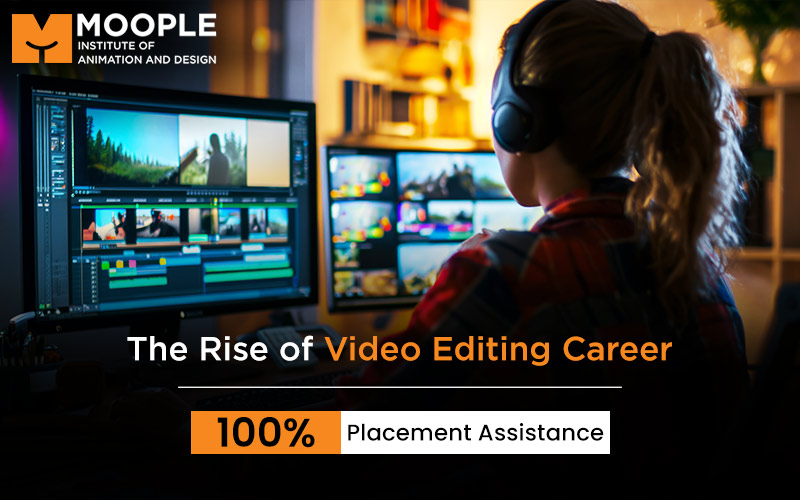This journey is incredibly exciting as starting up in the career of video editing offers you the freedom to pursue creative storytelling by applying various technical skills to it. Where do I begin, then? Innumerable options abound various tools and techniques and so many courses and tutorials-it all overwhelm you. Let me get you off to a great start.
This blog will discuss details such as video editing course fees or advice on how to get a portfolio created, pointing you in the perfect direction.
Step 1: Gain Insight Into The Responsibilities Of A Video Editor
Before entering video editing, one needs to understand the responsibility. A video editor takes raw footage and shapes it into a polished final product. He cuts scenes, adds transitions, and adjusts audio to tell a cohesive story. The work can range from movies to commercials to social media content.
Editing isn’t only a matter of computer software but is an art that composes between storytelling and time, with a highly attentive eye to detail. This makes a pro video editing course even more valuable.
Step 2: Get Familiar With Editing Software
From this good base, begin working with the industry-specific software. One example that is popular now is Premiere Pro from Adobe, as well as the others mentioned above. Most student of filmmaker newbies usually ask about getting software directly; still, in pro video editing courses, usually, a student would usually go through most of that training.
Each application has different characteristics, so learning one will make it easier when the time is right to do so. First, begin with such basic effects as cutting, layering, and applying audio.
Step 3: Choose The Right Course
Self-learning can be very effective at times, but a structured course provides many advantages. A professional video editing course offers a way that is accompanied by the guidance of professionals. There are many courses online available from free tutorials to courses with certifications and feeable programs.
The cost of the video editing course varies from institute to institute and course syllabus. Some courses are also attached with internships, which are a better way of gaining experience in the respective field.
Step 4: Practice with Real Projects
Theory alone will not turn you into a confident editor. Build confidence with experience by practicing on real projects: most websites use free stock footage; test trim, add transitions, or incorporate music.
Always continue practicing based on speed and efficiency. Search for some challenges like redoing some trailers or video montages to hone the skills.
Step 5: Develop an Editing Style
As you begin to practice, pay attention to the styles of edits that appeal to you. Each editor has a feel. Some like fast-paced cuts and others smooth, cinematic transitions.
Another great way to enhance your sense of style is by watching a lot of other editors, paying attention to how they allow scenes to flow, use music, and affect the tone through the cut.
Step 6: Create a Portfolio
A good portfolio is also important to show your skills. It will make clients understand your capabilities. Include only the best works. Quality is rather the case here than quantity.
Make sample projects if you have just started. All must show off another skill, such as color correction, sound editing, or visual effects.
Step 7: Research Job Opportunities
Once you have prepared your portfolio, you can then start seeking jobs. Specifically, search for internships, freelance jobs, or jr. editor jobs.
You may join a pro video editing course with placement help. LinkedIn, job boards and social media are also the best sources for job searching.
Step 8: Keep Learning and Stay Updated
Video editing is constantly changing. New software tools, plugins, and features emerge daily. Keep updating your knowledge with industry trends through blogs, tutorials on the web, and different online communities of editors.
Step 9: Network With Industry Professionals
Networking is another major career growth method. You have to attend each event, join all possible online communities, and connect to other editors. Networking may also be a great learning platform as it tells about jobs as well as learning some good tips from experience-rich people.
Step 10: Market Your Skills And Build A Brand
In the present world, personal branding is very essential. Share your work with the world through social media or a personal website. For editors, LinkedIn and Instagram are excellent platforms for showcasing their work.
Conclusion
It requires a lot of time, practice, and dedication to begin working in the video editing business. But these steps will prepare you with the right skills for success. From selecting the proper pro video editing course to developing a great portfolio, all these help you set up as a strong contender in the industry. The art of video editing calls for continuous growth and change.
For those who take this journey seriously, one may find professional courses useful for training and support. Moople Institute of Animation and Design offers courses specifically to equip aspiring editors with the necessary practical skills and knowledge that will guide them toward successful careers in video editing.

